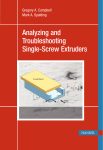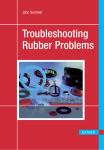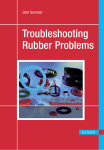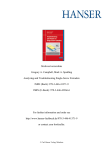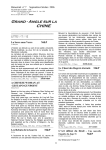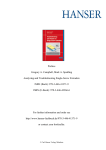Download Analyzing and Troubleshooting Single
Transcript
Gregory A. Campbell Mark A. Spalding Analyzing and Troubleshooting Single-Screw Extruders Campbell, Spalding Analyzing and Troubleshooting Single-Screw Extruders Gregory A. Campbell Mark A. Spalding Analyzing and Troubleshooting Single-Screw Extruders Hanser Publishers, Munich Hanser Publications, Cincinnati The Authors: Prof. Dr. Gregory A. Campbell, Clarkson University, Department of Chemical Engineering, Potsdam, NY 13676, USA Mark A. Spalding, The Dow Chemical Company, 433 Building, Midland, MI 48667, USA Distributed in North and South America by: Hanser Publications 6915 Valley Avenue, Cincinnati, Ohio 45244-3029, USA Fax: (513) 527-8801 Phone: (513) 527-8977 www.hanserpublications.com Distributed in all other countries by Carl Hanser Verlag Postfach 86 04 20, 81631 München, Germany Fax: +49 (89) 98 48 09 www.hanser-fachbuch.de The use of general descriptive names, trademarks, etc., in this publication, even if the former are not especially identified, is not to be taken as a sign that such names, as understood by the Trade Marks and Merchandise Marks Act, may accordingly be used freely by anyone. While the advice and information in this book are believed to be true and accurate at the date of going to press, neither the author nor the editors nor the publisher can accept any legal responsibility for any errors or omissions that may be made. The publisher makes no warranty, express or implied, with respect to the material contained herein. Cataloging-in-Publication Data is on file with the Library of Congress Bibliografische Information Der Deutschen Bibliothek Die Deutsche Bibliothek verzeichnet diese Publikation in der Deutschen Nationalbibliografie; detaillierte bibliografische Daten sind im Internet über <http://dnb.d-nb.de> abrufbar. ISBN 978-1-56990-448-0 E-Book ISBN 978-3-446-43266-6 All rights reserved. No part of this book may be reproduced or transmitted in any form or by any means, electronic or mechanical, including photocopying or by any information storage and retrieval system, without permission in writing from the publisher. © Carl Hanser Verlag, Munich 2013 Production Management: Steffen Jörg Coverconcept: Marc Müller-Bremer, www.rebranding.de, München Coverdesign: Stephan Rönigk Printed and bound by Kösel, Krugzell Printed in Germany Preface Classically, all prior extrusion books are based on barrel rotation physics. Literature developed over the past 15 years has led to this first book to be published based on the actual physics of the process—screw rotation physics. After the theories and the math models are developed in the first nine chapters, the models are then used to solve actual commercial problems in the remainder of the book. Realistic case studies are unique in that they describe the problem as viewed by the plant engineers and provide the actual dimensions of the screws. Knowledge is developed using a series of hypotheses that are developed and then tested, which allows a series of technical solutions. Several actual solutions are proposed with the final results that solve the problem then clearly presented. Overall, there is not a book on the market with this level of detail and disclosure. New knowledge in this book will be highly useful for production engineers, technical service engineers working with customers, consultants specializing in troubleshooting and process design, and process researchers and designers that are responsible for processes that run at maximum rates and maximum profitability. Debugging and troubleshooting single-screw extruders is an important skill set for plant engineers since all machines will eventually have a deterioration in their performance or a catastrophic failure. Original design performance must be restored as quickly as possible to mitigate production losses. With troubleshooting know ledge and a fundamental understanding of the process, the performance of the extruder can be restored in a relatively short time, minimizing the economic loss to the plant. Common root causes and their detection are provided. Hypothesis testing is outlined in Chapter 10 and is used throughout the troubleshooting chapters to identify the root causes. Elimination of the root cause is provided by offering the equipment owner several technical solutions, allowing the owner to choose the level of risk associated with the process modification. Mechanical failures are also common with single-screw extruders, and the common problems are identified. Illustrations are provided with the problems along with many numerical simulations of the case studies. Collectively, these instruct the reader on how to determine and solve many common extrusion problems. About 100 case studies and defects are identified in the book with acceptable technical solutions. Lastly, we VIPreface hope that this book provides the information and technology that is required for the understanding, operation, and troubleshooting of single-screw extruders. Gregory A. Campbell Mark A. Spalding The views and opinions expressed in this book are soley those of the authors and contributors. These views and opinions do not necessarily reflect the views and opinions of any affiliated individuals, companies, or trade associations. Acknowledgements My interest in fundamental polymer research began in 1964 when I began my graduate career. My research efforts were strongly influenced by my mentor Professor Edward G. Bobalek, one of finest gentleman and innovative research minds I have ever met. My research philosophy was strongly influenced by many encounters with Ed before and after I defended my dissertation. One particularly important encounter occurred when I was lamenting that my dissertation research did not appear to be a really important breakthrough. He took a long draw on his ever present pipe and said “Greg, that is why we call it research and not search.” From that time on I have always looked at my efforts as learning from the previous researchers that have laid the technical foundation in the area that is now being addressed. My role is thus to continue to build on that foundation when looking for a solution to the research challenge that I am currently addressing. After leaving the University of Maine, I worked with wonderful groups of exceptional researchers at General Motors research, Mobil Chemical research, and Clarkson University. Many of these individuals spent their valuable time to help me hone my research skills. Probably the most influential individual was Dr. William Meluch; a true genius that I had the pleasure of working with for 13 years. Another good friend that had a major influence on my manner of approaching engineering research was Professor Art Fricke whom I collaborated with at the University of Maine and the University of Florida. My colleague Dr. Don Rassmussen at Clarkson University provided important guidance in all things thermodynamic. My extrusion experience started when I directed process research at Mobil Chemical Research in the early 1980s. We developed and analyzed data on a 24 to 1 singlescrew extruder with 12 infrared probes and 12 pressure probes using high-speed data acquisition. I then changed career paths and accepted a position at Clarkson University teaching chemical engineering while developing the Clarkson Polymer Processing Laboratory. The new concepts developed in this book were first recognized by Dr. Paul Sweeney when he was a graduate student in about 1988. I have to admit that it took considerable effort on Paul’s part to convince me to even address these new concepts. Once we became convinced that it was important to complete the solution of the single-screw extruder analysis and bring the solution VIIIAcknowledgements back to the laboratory frame, it has taken 25 years to reach our current incomplete understanding. I would not have been able to acquire this understanding without the dedication and efforts of my colleagues and students that led the extrusion research in my lab: Paul Sweeney, Jeff Felton, Douglas Small, ChiCheng Wang, Dontula Narasimharao, Diana Hunt, Hongying Cheng, Zirong Tang, Mary Ann te-Riele, Jason C. Baird, Sirisha Bomma, and Sam St. John. An academic without excellent students is severely handicapped and I can truly say that I was not handicapped. The development of this book has been an interesting and exhausting “trip” which in all likelihood would not have been completed without the encouragement and understanding of Sue, my wife for the past 50 years. Gregory A. Campbell, Castle Research, Jonesport, Maine My extrusion career started as one of the founding members of the Polymer Processing Technology Team of The Dow Chemical Company in 1987. The team was built and led by Dr. Kun Sup Hyun and consisted of four members (along with Joseph Dooley and Thomas McCullough). During the early years, the team researched many aspects of polymer processing including single-screw extrusion, twin-screw extrusion, and die technologies. These early years allowed the team to develop strong skills in process fundamentals, design, and troubleshooting. I am grateful to have this experience and the opportunity to develop this skill set. I am also grateful for the many mentors that I have had through my life including my father, Robert Bean, Gene Kratzman, Prof. Lyle F. Albright, and Dr. Hyun. A book like this would not be possible without the help and contributions from coworkers, industry experts, and family. Many of the figures were contributed by industry experts and their names are provided with the figure. Photographs, content, and assistance were provided by Timothy W. Womer (consultant), Jeffery Kuhlman (Glycon), Jeff Myers (Robert Barr, Inc.), James Fogharty (Plastics Engineering Associates Licensing, Inc.), John Christiano (Davis-Standard), William Kramer (American Kuhne), and many others. Numerous diagrams were made and enhanced by my sons Stephen W. Spalding and Aaron F. Spalding. I also thank those who reviewed the original chapter drafts. My wife Pamela has been a source of inspiration and motivation during this project. I thank her and my sons for their continued support through the writing of this book. My parents William and Joan provided me with a loving environment while growing up, and they provided the foundation for success. Mark A. Spalding, The Dow Chemical Company, Midland, MI Contents Preface . . . . . . . . . . . . . . . . . . . . . . . . . . . . . . . . . . . . . . . . . . . . . . . . . . . . . . . . V Acknowledgements . . . . . . . . . . . . . . . . . . . . . . . . . . . . . . . . . . . . . . . . . . . . . VII 1 Single-Screw Extrusion: Introduction and Troubleshooting . . 1 1.1 Organization of this Book . . . . . . . . . . . . . . . . . . . . . . . . . . . . . . . . . . . . . 3 1.2 Troubleshooting Extrusion Processes . . . . . . . . . . . . . . . . . . . . . . . . . . . 5 1.2.1 The Injection Molding Problem at Saturn . . . . . . . . . . . . . . . . . . 6 1.3 Introduction to Screw Geometry . . . . . . . . . . . . . . . . . . . . . . . . . . . . . . . . 6 1.3.1 Screw Geometric Quantitative Characteristics . . . . . . . . . . . . . . 8 1.4 Simple Flow Equations for the Metering Section . . . . . . . . . . . . . . . . . . 11 1.5 Example Calculations . . . . . . . . . . . . . . . . . . . . . . . . . . . . . . . . . . . . . . . . . 15 1.5.1 Example 1: Calculation of Rotational and Pressure Flow Components . . . . . . . . . . . . . . . . . . . . . . . . . . . . . . . . . . . . . . . . . . 15 1.5.2 Example 2: Flow Calculations for a Properly Operating Extruder . . . . . . . . . . . . . . . . . . . . . . . . . . . . . . . . . . . . . . . . . . . . . 17 1.5.3 Example 3: Flow Calculations for an Improperly Operating Extruder . . . . . . . . . . . . . . . . . . . . . . . . . . . . . . . . . . . . . . . . . . . . . 18 1.5.4 Metering Channel Calculation Summary . . . . . . . . . . . . . . . . . . 20 Nomenclature . . . . . . . . . . . . . . . . . . . . . . . . . . . . . . . . . . . . . . . . . . . . . . . . . . . . 20 References . . . . . . . . . . . . . . . . . . . . . . . . . . . . . . . . . . . . . . . . . . . . . . . . . . . . . . . 22 2 Polymer Materials . . . . . . . . . . . . . . . . . . . . . . . . . . . . . . . . . . . . . . . . . 23 2.1 Introduction and History . . . . . . . . . . . . . . . . . . . . . . . . . . . . . . . . . . . . . . 24 2.1.1 History of Natural Polymers . . . . . . . . . . . . . . . . . . . . . . . . . . . . . 25 2.1.2 The History of Synthetic Polymers . . . . . . . . . . . . . . . . . . . . . . . 26 2.2 Characteristics of Synthetic Polymers . . . . . . . . . . . . . . . . . . . . . . . . . . . 28 2.3 Structure Effects on Properties . . . . . . . . . . . . . . . . . . . . . . . . . . . . . . . . . 31 2.3.1Stereochemistry . . . . . . . . . . . . . . . . . . . . . . . . . . . . . . . . . . . . . . . 34 2.3.2 Melting and Glass Transition Temperatures . . . . . . . . . . . . . . . . 35 2.3.3Crystallinity . . . . . . . . . . . . . . . . . . . . . . . . . . . . . . . . . . . . . . . . . . 37 XContents 2.4 Polymer Production and Reaction Engineering . . . . . . . . . . . . . . . . . . . . 40 2.4.1 Condensation Reactions . . . . . . . . . . . . . . . . . . . . . . . . . . . . . . . . 40 2.4.2 Addition Reactions . . . . . . . . . . . . . . . . . . . . . . . . . . . . . . . . . . . . . 43 2.5 Polymer Degradation . . . . . . . . . . . . . . . . . . . . . . . . . . . . . . . . . . . . . . . . . 46 2.5.1 Ceiling Temperature . . . . . . . . . . . . . . . . . . . . . . . . . . . . . . . . . . . 49 2.5.2 Degradation of Vinyl Polymers . . . . . . . . . . . . . . . . . . . . . . . . . . . 51 2.5.3 Degradation of Condensation Polymers . . . . . . . . . . . . . . . . . . . 53 References . . . . . . . . . . . . . . . . . . . . . . . . . . . . . . . . . . . . . . . . . . . . . . . . . . . . . . . 54 3 Introduction to Polymer Rheology for Extrusion . . . . . . . . . . . . 57 3.1 Introduction to the Deformation of Materials . . . . . . . . . . . . . . . . . . . . . 57 3.2 Introduction to Basic Concepts of Molecular Size . . . . . . . . . . . . . . . . . . 58 3.2.1 Size Distribution Example . . . . . . . . . . . . . . . . . . . . . . . . . . . . . . 59 3.2.2 Molecular Weight Distributions for Polymers . . . . . . . . . . . . . . . 60 3.3 Basic Rheology Concepts . . . . . . . . . . . . . . . . . . . . . . . . . . . . . . . . . . . . . . 63 3.4 Polymer Solution Viscosity and Polymer Molecular Weight . . . . . . . . . 67 3.4.1 Sample Calculation of Solution Viscosity . . . . . . . . . . . . . . . . . . 71 3.5 Introduction to Viscoelasticity . . . . . . . . . . . . . . . . . . . . . . . . . . . . . . . . . 72 3.6 Measurement of Polymer Viscosity . . . . . . . . . . . . . . . . . . . . . . . . . . . . . 80 3.6.1 Capillary Rheometers . . . . . . . . . . . . . . . . . . . . . . . . . . . . . . . . . . 80 3.6.2 Cone and Plate Rheometers . . . . . . . . . . . . . . . . . . . . . . . . . . . . . 91 3.6.3 Melt Index and Melt Flow Rate . . . . . . . . . . . . . . . . . . . . . . . . . . . 94 3.7 Viscosity of Polymers as Functions of Molecular Character, Temperature, and Pressure . . . . . . . . . . . . . . . . . . . . . . . . . . . . . . . . . . . . 97 3.8 Models for Non-Newtonian Flow . . . . . . . . . . . . . . . . . . . . . . . . . . . . . . . . 103 Nomenclature . . . . . . . . . . . . . . . . . . . . . . . . . . . . . . . . . . . . . . . . . . . . . . . . . . . . 105 References . . . . . . . . . . . . . . . . . . . . . . . . . . . . . . . . . . . . . . . . . . . . . . . . . . . . . . . 107 4 Resin Physical Properties Related to Processing . . . . . . . . . . . . 109 4.1 Bulk Density and Compaction . . . . . . . . . . . . . . . . . . . . . . . . . . . . . . . . . . 110 4.1.1 Measurement of Bulk Density . . . . . . . . . . . . . . . . . . . . . . . . . . . 111 4.1.2 Measuring the Compaction Characteristics of a Resin . . . . . . . 112 4.2 Lateral Stress Ratio . . . . . . . . . . . . . . . . . . . . . . . . . . . . . . . . . . . . . . . . . . . 115 4.2.1 Measuring the Lateral Stress Ratio . . . . . . . . . . . . . . . . . . . . . . . 116 4.3 Stress at a Sliding Interface . . . . . . . . . . . . . . . . . . . . . . . . . . . . . . . . . . . . 118 4.3.1 The Screw Simulator and the Measurement of the Stress at the Interface . . . . . . . . . . . . . . . . . . . . . . . . . . . . . . . . . . . . . . . . 119 Contents XI 4.4 Melting Flux . . . . . . . . . . . . . . . . . . . . . . . . . . . . . . . . . . . . . . . . . . . . . . . . 121 4.5 Heat Capacity . . . . . . . . . . . . . . . . . . . . . . . . . . . . . . . . . . . . . . . . . . . . . . . 123 4.6 Thermal Conductivity and Heat Transfer . . . . . . . . . . . . . . . . . . . . . . . . . 124 4.7 Melt Density . . . . . . . . . . . . . . . . . . . . . . . . . . . . . . . . . . . . . . . . . . . . . . . . 125 Nomenclature . . . . . . . . . . . . . . . . . . . . . . . . . . . . . . . . . . . . . . . . . . . . . . . . . . . . 127 References . . . . . . . . . . . . . . . . . . . . . . . . . . . . . . . . . . . . . . . . . . . . . . . . . . . . . . . 127 5 Solids Conveying . . . . . . . . . . . . . . . . . . . . . . . . . . . . . . . . . . . . . . . . . . 131 5.1 Description of the Solid Conveying Process . . . . . . . . . . . . . . . . . . . . . . . 132 5.2 Literature Review of Smooth-Bore Solids Conveying Models . . . . . . . . . 134 5.2.1 Darnell and Mol Model . . . . . . . . . . . . . . . . . . . . . . . . . . . . . . . . . 137 5.2.2 Tadmor and Klein Model . . . . . . . . . . . . . . . . . . . . . . . . . . . . . . . . 138 5.2.3 Clarkson University Models . . . . . . . . . . . . . . . . . . . . . . . . . . . . . 139 5.2.4 Hyun and Spalding Model . . . . . . . . . . . . . . . . . . . . . . . . . . . . . . 142 5.2.5 Moysey and Thompson Model . . . . . . . . . . . . . . . . . . . . . . . . . . . 143 5.3 Modern Experimental Solids Conveying Devices . . . . . . . . . . . . . . . . . . 143 5.3.1 Solids Conveying Devices at Clarkson University . . . . . . . . . . . 144 5.3.2 The Solids Conveying Device at Dow . . . . . . . . . . . . . . . . . . . . . . 158 5.4 Comparison of the Modified Campbell-Dontula Model with Experimental Data . . . . . . . . . . . . . . . . . . . . . . . . . . . . . . . . . . . . . . . . . . . 168 5.4.1 Solids Conveying Example Calculation . . . . . . . . . . . . . . . . . . . . 172 5.5 Grooved Bore Solids Conveying . . . . . . . . . . . . . . . . . . . . . . . . . . . . . . . . . 174 5.5.1 Grooved Barrel Solids Conveying Models . . . . . . . . . . . . . . . . . . 178 5.6 Solids Conveying Notes . . . . . . . . . . . . . . . . . . . . . . . . . . . . . . . . . . . . . . . 180 Nomenclature . . . . . . . . . . . . . . . . . . . . . . . . . . . . . . . . . . . . . . . . . . . . . . . . . . . . 183 References . . . . . . . . . . . . . . . . . . . . . . . . . . . . . . . . . . . . . . . . . . . . . . . . . . . . . . . 185 6 The Melting Process . . . . . . . . . . . . . . . . . . . . . . . . . . . . . . . . . . . . . . . 189 6.1 Compression Ratio and Compression Rate . . . . . . . . . . . . . . . . . . . . . . . 191 6.2 The Melting Process . . . . . . . . . . . . . . . . . . . . . . . . . . . . . . . . . . . . . . . . . . 193 6.2.1 The Melting Process as a Function of Screw Geometry . . . . . . . 194 6.2.2 Review of the Classical Literature . . . . . . . . . . . . . . . . . . . . . . . . 199 6.2.3 Reevaluation of the Tadmor and Klein Melting Data . . . . . . . . . 200 6.3 Theory Development for Melting Using Screw Rotation Physics . . . . . . 203 6.3.1 Melting Model for a Conventional Transition Section Using Screw Rotation Physics . . . . . . . . . . . . . . . . . . . . . . . . . . . . . . . . . 204 6.3.2 Melting Models for Barrier Screw Sections . . . . . . . . . . . . . . . . 218 XIIContents 6.4 Effect of Pressure on Melting Rate . . . . . . . . . . . . . . . . . . . . . . . . . . . . . . 227 6.5 One-Dimensional Melting . . . . . . . . . . . . . . . . . . . . . . . . . . . . . . . . . . . . . 228 6.5.1 One-Dimensional Melting Model . . . . . . . . . . . . . . . . . . . . . . . . . 232 6.6 Solid Bed Breakup . . . . . . . . . . . . . . . . . . . . . . . . . . . . . . . . . . . . . . . . . . . 234 6.7 Melting Section Characteristics . . . . . . . . . . . . . . . . . . . . . . . . . . . . . . . . 238 Nomenclature . . . . . . . . . . . . . . . . . . . . . . . . . . . . . . . . . . . . . . . . . . . . . . . . . . . . 240 References . . . . . . . . . . . . . . . . . . . . . . . . . . . . . . . . . . . . . . . . . . . . . . . . . . . . . . . 242 7 Fluid Flow in Metering Channels . . . . . . . . . . . . . . . . . . . . . . . . . . . 247 7.1 Introduction to the Reference Frame . . . . . . . . . . . . . . . . . . . . . . . . . . . . 247 7.2 Laboratory Observations . . . . . . . . . . . . . . . . . . . . . . . . . . . . . . . . . . . . . . 250 7.3 Literature Survey . . . . . . . . . . . . . . . . . . . . . . . . . . . . . . . . . . . . . . . . . . . . 254 7.4 Development of Linearized Flow Analysis . . . . . . . . . . . . . . . . . . . . . . . . . 259 7.4.1 Example Flow Calculation . . . . . . . . . . . . . . . . . . . . . . . . . . . . . . . 274 7.5 Numerical Flow Evaluation . . . . . . . . . . . . . . . . . . . . . . . . . . . . . . . . . . . . 277 7.5.1 Simulation of a 500 mm Diameter Melt-Fed Extruder . . . . . . . . 279 7.5.2 Extrusion Variables and Errors . . . . . . . . . . . . . . . . . . . . . . . . . . 281 7.5.3 Corrections to Rotational Flow . . . . . . . . . . . . . . . . . . . . . . . . . . . 287 7.5.4 Simulation of the 500 mm Diameter Extruder Using Fc . . . . . . 292 7.6 Frame Dependent Variables . . . . . . . . . . . . . . . . . . . . . . . . . . . . . . . . . . . 293 7.6.1 Example Calculation of Energy Dissipation . . . . . . . . . . . . . . . . 296 7.7 Viscous Energy Dissipation and Temperature of the Resin in the Channel . . . . . . . . . . . . . . . . . . . . . . . . . . . . . . . . . . . . . . . . . . . . . . . . . . . . 297 7.7.1 Energy Dissipation and Channel Temperature for Screw Rotation . . . . . . . . . . . . . . . . . . . . . . . . . . . . . . . . . . . . . . . . . . . . . . 303 7.7.2 Energy Dissipation and Channel Temperature for Barrel Rotation . . . . . . . . . . . . . . . . . . . . . . . . . . . . . . . . . . . . . . . . . . . . . . 307 7.7.3 Temperature Increase Calculation Example for a Screw Pump 308 7.7.4 Heat Transfer Coefficients . . . . . . . . . . . . . . . . . . . . . . . . . . . . . . 313 7.7.5 Temperature Calculation Using a Control Volume Technique . 314 7.7.6 Numerical Comparison of Temperatures for Screw and Barrel Rotations . . . . . . . . . . . . . . . . . . . . . . . . . . . . . . . . . . . . . . . 317 7.8 Metering Section Characteristics . . . . . . . . . . . . . . . . . . . . . . . . . . . . . . . 319 Nomenclature . . . . . . . . . . . . . . . . . . . . . . . . . . . . . . . . . . . . . . . . . . . . . . . . . . . . 321 References . . . . . . . . . . . . . . . . . . . . . . . . . . . . . . . . . . . . . . . . . . . . . . . . . . . . . . . 325 Contents XIII 8 Mixing Processes for Single-Screw Extruders . . . . . . . . . . . . . . . 329 8.1 Common Mixing Operations for Single-Screw Extruders . . . . . . . . . . . . 330 8.1.1 Common Mixing Applications . . . . . . . . . . . . . . . . . . . . . . . . . . . 331 8.2 Dispersive and Distributive Mixing Processes . . . . . . . . . . . . . . . . . . . . 333 8.3 Fundamentals of Mixing . . . . . . . . . . . . . . . . . . . . . . . . . . . . . . . . . . . . . . 335 8.3.1 Measures of Mixing . . . . . . . . . . . . . . . . . . . . . . . . . . . . . . . . . . . . 336 8.3.2 Experimental Demonstration of Mixing . . . . . . . . . . . . . . . . . . . 338 8.4 The Melting Process as the Primary Mechanism for Mixing . . . . . . . . . 346 8.4.1 Experimental Analysis of the Melting and Mixing Capacity of a Screw . . . . . . . . . . . . . . . . . . . . . . . . . . . . . . . . . . . . . . . . . . . . 349 8.4.2 Mixing and Barrier-Flighted Melting Sections . . . . . . . . . . . . . . 352 8.5 Secondary Mixing Processes and Devices . . . . . . . . . . . . . . . . . . . . . . . . . . 353 8.5.1 Maddock-Style Mixers . . . . . . . . . . . . . . . . . . . . . . . . . . . . . . . . . . 354 8.5.2 Blister Ring Mixers . . . . . . . . . . . . . . . . . . . . . . . . . . . . . . . . . . . . 359 8.5.3 Spiral Dam Mixers . . . . . . . . . . . . . . . . . . . . . . . . . . . . . . . . . . . . . 361 8.5.4 Pin-Type Mixers . . . . . . . . . . . . . . . . . . . . . . . . . . . . . . . . . . . . . . . 362 8.5.5 Knob Mixers . . . . . . . . . . . . . . . . . . . . . . . . . . . . . . . . . . . . . . . . . . 363 8.5.6 Gear Mixers . . . . . . . . . . . . . . . . . . . . . . . . . . . . . . . . . . . . . . . . . . 364 8.5.7 Dynamic Mixers . . . . . . . . . . . . . . . . . . . . . . . . . . . . . . . . . . . . . . . 364 8.5.8 Static Mixers . . . . . . . . . . . . . . . . . . . . . . . . . . . . . . . . . . . . . . . . . 367 8.6 Mixing Using Natural Resins and Masterbatches . . . . . . . . . . . . . . . . . . 374 8.7 Mixing and Melting Performance as a Function of Flight Clearance . . 375 8.8 High Pressures During Melting and Agglomerates . . . . . . . . . . . . . . . . 376 8.9 Effect of Discharge Pressure on Mixing . . . . . . . . . . . . . . . . . . . . . . . . . . 376 8.10 Shear Refinement . . . . . . . . . . . . . . . . . . . . . . . . . . . . . . . . . . . . . . . . . . . . 377 8.11 Direct Compounding Using Single-Screw Extruders . . . . . . . . . . . . . . . 379 Nomenclature . . . . . . . . . . . . . . . . . . . . . . . . . . . . . . . . . . . . . . . . . . . . . . . . . . . . 380 References . . . . . . . . . . . . . . . . . . . . . . . . . . . . . . . . . . . . . . . . . . . . . . . . . . . . . . . 382 9 Scaling of Single-Screw Extrusion Processes . . . . . . . . . . . . . . . 387 9.1 Scaling Rules . . . . . . . . . . . . . . . . . . . . . . . . . . . . . . . . . . . . . . . . . . . . . . . . 388 9.2 Engineering Design Method for Plasticating Screws . . . . . . . . . . . . . . . 389 9.2.1 Process Analysis and Simulations . . . . . . . . . . . . . . . . . . . . . . . . 393 9.3 Scale-Up from a 40 mm Diameter Extruder to an 80 mm Diameter Machine for a PE Resin . . . . . . . . . . . . . . . . . . . . . . . . . . . . . . . . . . . . . . . 393 9.4 Rate Increase for an 88.9 mm Diameter Extruder Running a HIPS Resin 397 Nomenclature . . . . . . . . . . . . . . . . . . . . . . . . . . . . . . . . . . . . . . . . . . . . . . . . . . . . 404 References . . . . . . . . . . . . . . . . . . . . . . . . . . . . . . . . . . . . . . . . . . . . . . . . . . . . . . . 405 XIVContents 10 Introduction to Troubleshooting the Extrusion Process . . . . . 407 10.1 The Troubleshooting Process . . . . . . . . . . . . . . . . . . . . . . . . . . . . . . . . . . . 408 10.2 Hypothesis Setting and Problem Solving . . . . . . . . . . . . . . . . . . . . . . . . . . . 411 10.2.1 Case Study for the Design of a New Resin . . . . . . . . . . . . . . . . . 412 10.2.2 Case Study for a Surface Blemish . . . . . . . . . . . . . . . . . . . . . . . . 414 10.2.3 Case Study for a Profile Extrusion Process . . . . . . . . . . . . . . . . . 415 10.3 Equipment and Tools Needed for Troubleshooting . . . . . . . . . . . . . . . . . 416 10.3.1 Maddock Solidification Experiment . . . . . . . . . . . . . . . . . . . . . . . 418 10.4 Common Mechanical Problems . . . . . . . . . . . . . . . . . . . . . . . . . . . . . . . . . 419 10.4.1 Flight Clearance and Hard Facing . . . . . . . . . . . . . . . . . . . . . . . . 419 10.4.2 Barrel and Screw Alignment . . . . . . . . . . . . . . . . . . . . . . . . . . . . 421 10.4.3 Extruder Barrel Supports . . . . . . . . . . . . . . . . . . . . . . . . . . . . . . . 422 10.4.4 First-Time Installation of a Screw . . . . . . . . . . . . . . . . . . . . . . . . 424 10.4.5 Screw Breaks . . . . . . . . . . . . . . . . . . . . . . . . . . . . . . . . . . . . . . . . . 425 10.4.6 Protection from High-Pressure Events . . . . . . . . . . . . . . . . . . . . . 427 10.4.7 Gearbox Lubricating Oil . . . . . . . . . . . . . . . . . . . . . . . . . . . . . . . . 429 10.4.8 Particle Seals and Viscoseals . . . . . . . . . . . . . . . . . . . . . . . . . . . . 429 10.4.9 Screw Cleaning . . . . . . . . . . . . . . . . . . . . . . . . . . . . . . . . . . . . . . . 431 10.5 Common Electrical and Sensor Problems . . . . . . . . . . . . . . . . . . . . . . . . 431 10.5.1Thermocouples . . . . . . . . . . . . . . . . . . . . . . . . . . . . . . . . . . . . . . . . 432 10.5.2 Pressure Sensors . . . . . . . . . . . . . . . . . . . . . . . . . . . . . . . . . . . . . . 432 10.5.3 Electronic Filters and Noise . . . . . . . . . . . . . . . . . . . . . . . . . . . . . 433 10.6 Motors and Drive Systems . . . . . . . . . . . . . . . . . . . . . . . . . . . . . . . . . . . . . 435 10.6.1 Motor Efficiencies and Power Factors . . . . . . . . . . . . . . . . . . . . . 437 10.7 Typical Screw Channel Dimensions . . . . . . . . . . . . . . . . . . . . . . . . . . . . . 438 10.8 Common Calculations . . . . . . . . . . . . . . . . . . . . . . . . . . . . . . . . . . . . . . . . 439 10.8.1 Energy Dissipated by the Screw . . . . . . . . . . . . . . . . . . . . . . . . . . 439 10.8.2 Screw Geometry Indices . . . . . . . . . . . . . . . . . . . . . . . . . . . . . . . . 440 10.9 Barrel Temperature Optimization . . . . . . . . . . . . . . . . . . . . . . . . . . . . . . . 442 10.10 Screw Temperature Profile . . . . . . . . . . . . . . . . . . . . . . . . . . . . . . . . . . . . 445 10.11 The Screw Manufacturing and Refurbishing Process . . . . . . . . . . . . . . . 454 10.12 Injection-Molding Plasticators . . . . . . . . . . . . . . . . . . . . . . . . . . . . . . . . . . 462 10.12.1 Calculations for Injection-Molding Plasticators . . . . . . . . . . . . . 464 10.13 New Equipment Installations . . . . . . . . . . . . . . . . . . . . . . . . . . . . . . . . . . 464 10.13.1 Case Study: A Large Diameter Extruder Purchase . . . . . . . . . . . 468 10.13.2 Case Study: Extruder and Line Purchase for a New Product . . . 469 10.13.3 Summary for New Equipment Installations . . . . . . . . . . . . . . . . 470 Nomenclature . . . . . . . . . . . . . . . . . . . . . . . . . . . . . . . . . . . . . . . . . . . . . . . . . . . . 471 References . . . . . . . . . . . . . . . . . . . . . . . . . . . . . . . . . . . . . . . . . . . . . . . . . . . . . . . 473















